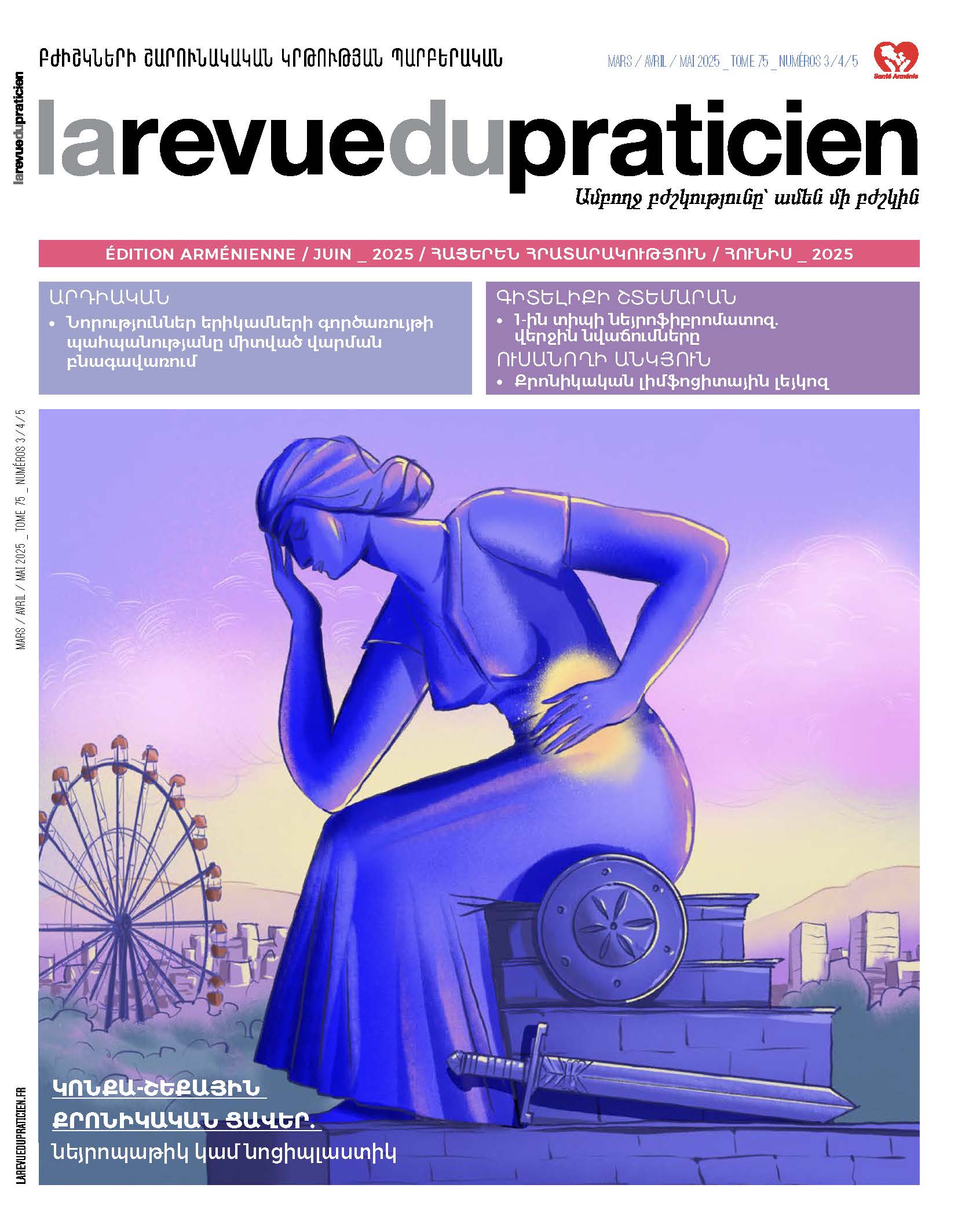Ամփոփագիր
Ցավոտ միզապարկի համախտանիշը (ՄՑՀ) հաճախ զուգակցվում է կոնքի այլ ցավային համախտանիշների հետ և սահմանվում է որպես միզապարկի հետ կապված քրոնիկական ցավի կամ անհարմարավետության զգացողություն, որը համակցվում է միզարձակման խանգարումների այլ ախտանշանների հետ, ինչպիսիք են հաճախամիզությունը (պոլակիուրիա) կամ անընդհատ միզելու ցանկությունը՝ օրգանական հիվանդության բացակայության պայմաններում: ՑՄՀ-ն ավելի հաճախ ախտահարում է կանանց։ Կլինիկական գնահատումը ներառում է միզարձակման օրագիր և կյանքի որակի վրա ազդեցությունը չափող միօրինականացված հարցաթերթիկներ: Առանցքային հետազոտությունը ցիստոսկոպիան է՝ տեղային կամ ընդհանուր անզգայացման ներքո, որը հնարավորություն է տալիս բացառելու միզապարկի ուռուցք տարբերակիչ ախտորոշումը և ՑՄՀ-ը դասակարգելու երկու նոզոլոգիական միավորի կամ ֆենոտիպի՝ գերզգայունացած միզապարկ՝ առանց միզապարկի պատի ախտահարման, և «ինտերստիցիալ ցիստիտ»՝ առպատային ախտահարումով, որը բնութագրվում է առանձնահատուկ հյուսվածաբանական և երբեմն էնդոսկոպիկ ախտահարումների առկայությամբ, ինչպիսիք են Հաների խոցերը։ Այս երկու հիվանդությունների ախտաֆիզիոլոգիան տարբեր է և ընդգրկում է բազմաթիվ գործոններ, ինչպիսիք են բորբոքումը, աուտոիմունությունը, վարակները, շրջակա միջավայրը, ուրոթելային պատնեշի գործառույթի խանգարումը, կոնքի կամ կենտրոնական զգայունացումը և արտամիզապարկային խանգարումները։
ՑՄՀ-ը պահանջում է համապարփակ և բազմաբնագավառային վարում։ Բուժման առաջին շարքը սովորաբար ներառում է ցիստոսկոպիա՝ ջրընդլայնմամբ (հիդրոդիստենզիա)՝ առպատային ձևերի դեպքում, ամիտրիպտիլինի ընդունում, ֆիզիոթերապիա, սննդային ռեժիմ և ՆԱԷԽ (նյարդերի անդրմաշկային էլեկտրախթանում):
Հիմքում ընկած մեխանիզմների ավելի լավ ըմբռնումը հնարավորություն կընձեռի առաջարկելու ավելի անհատականացված բուժում՝ ՑՄՀ-ի ֆենոտիպին համապատասխան։
Résumé
Le syndrome douloureux vésical (SDV), souvent associé aux autres syndromes douloureux pelviens, est défini comme une douleur ou un inconfort chronique en relation avec la vessie, associé à d’autres symptômes urinaires tels qu’une pollakiurie ou une envie permanente d’uriner, en l’absence de pathologie organique. Il touche plus souvent les femmes. Le bilan clinique comprend un calendrier mictionnel et des questionnaires standardisés mesurant l’impact sur la qualité de vie. L’examen clé est la cystoscopie, sous anesthésie locale ou générale, permettant d’éliminer le diagnostic différentiel de tumeur de la vessie et de séparer le SDV en deux entités ou phénotypes : la vessie hypersensible, sans lésion de la paroi vésicale, et la « cystite interstitielle », avec lésion pariétale, caractérisée par la présence de lésions histologiques spécifiques et parfois endoscopiques type ulcérations de Hunner. La physiopathologie serait différente entre ces entités, impliquant de multiples facteurs, tels que l’inflammation, l’auto-immunité, les infections, l’environnement, une dysfonction de la barrière urothéliale, la sensibilisation pelvienne ou centrale et les troubles extravésicaux. Le SDV nécessite une prise en charge globale et multidisciplinaire. La première ligne de traitement comprend habituellement une cystoscopie avec hydrodistension en cas de forme pariétale, l’introduction de l’amitriptyline, la kinésithérapie, un régime alimentaire et la TENS transcutaneous electrical nerve stimulation, neurostimulation électrique transcutanée). Une meilleure compréhension des mécanismes sous-jacents permettrait de proposer un traitement encore davantage individualisé, spécifique du phénotype de SDV
Abstract
Bladder pain syndrome (BPS), often associated with other pelvic pain syndromes, is defined as perceived chronic pain or discomfort related to the bladder, associated with other urinary symptoms such as pollakiuria or a constant urge to urinate, in the absence of organic pathology. It more often affects women. Assessment is clinical, including a voiding schedule and standardized questionnaires measuring impact on quality of life. The key examination is cystoscopy, under local or general anaesthetic, to rule out the differential diagnosis of bladder tumour and separate VDS into two entities or phenotypes: hypersensitive bladder, with no lesion of the bladder wall, and "interstitial cystitis" with parietal lesion, characterized by the presence of specific histological and sometimes endoscopic lesions such as Hunner's ulcerations. Pathophysiology is thought to differ between these entities, involving multiple factors such as inflammation, autoimmunity, infection, environment, urothelial barrier dysfunction, pelvic or central sensitization and extra-vesical disorders. BPS requires comprehensive, multidisciplinary patient management. The first line of treatment usually includes cystoscopy with hydrodistension in the case of parietal forms, introduction of amitriptyline, physiotherapy, diet and TENS (Transcutaneous Electrical Nerve Stimulation). A better understanding of the underlying mechanisms would enable us to propose an even more individualized treatment, specific to the BPS phenotype.
